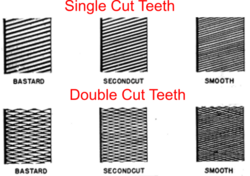Filing
From DT Online
Description
Files are abrading tools used to remove small amounts of metal and plastics. The teeth of a file are known as the ‘cut’ and are created by a ‘single cut’ across the file blade or a ‘double cut’ which creates diamond shaped teeth. Common ‘cuts’ of files are graded as smooth, second cut and bastard cut.
Using Files
- Grip the file with both hands, file close to the vice and always try to arrange the work such that filing is done horizontally as shown. File at and angle and change stance and direction of filing from time to time such that the file marks left previously can easily be seen - this will help improve accuracy by guiding further filing. The aim should be to progress along the full length to be filed with each full stroke of the file.
- Draw Filing is done by holding a file with one hand each end across the edge of material and drawing it backwards and forwards to smooth out file marks.
- When filing convex curves the file should rolled around an imaginary opposite curve as shown

|

|

|











